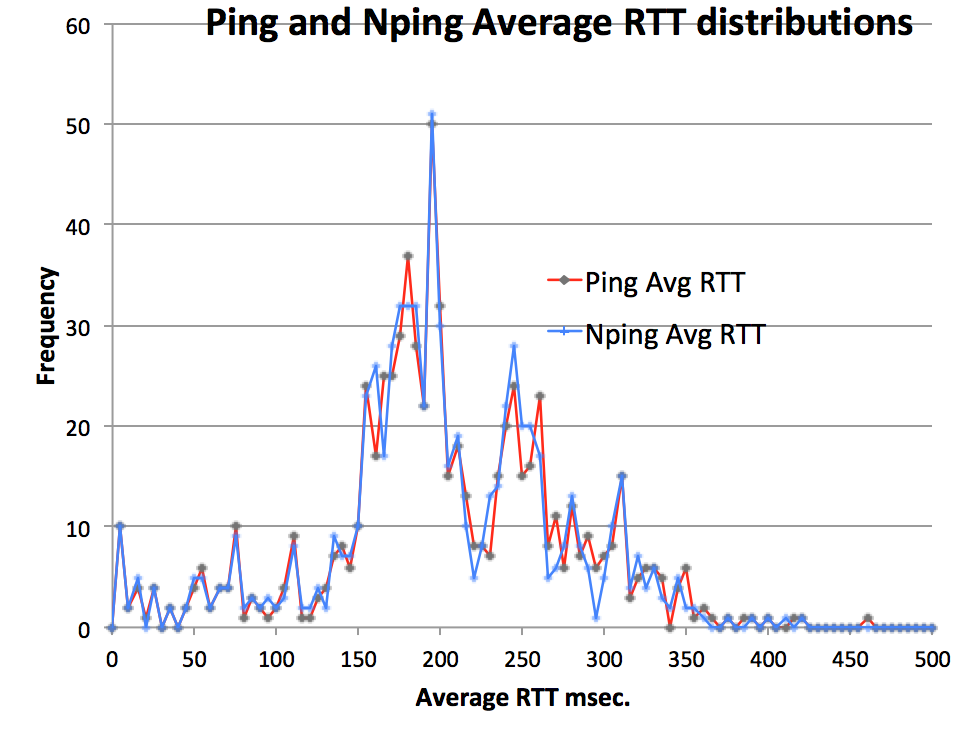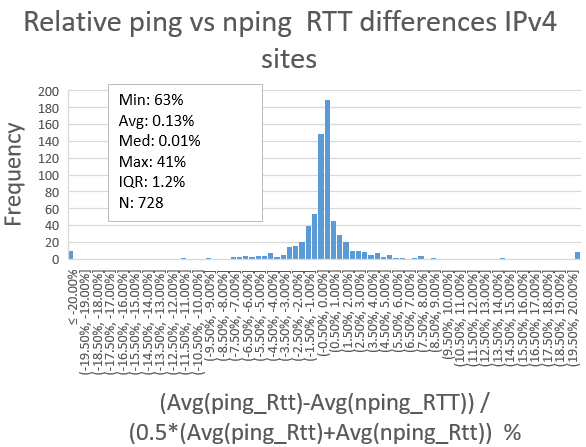...
| Code Block |
|---|
Usage: ping-vs-tcp.pl [opts]
Opts:
-v print this USAGE information
-D debug_level (default=0)
-p protocol (6 or '') (default '')
-a application port (default = 80)
-c count of pinfs to be sent (default = 10)
Function:
Ping the host provided in %NODE_DETAILS (the PingER database of hosts)
For each host it gets the IP address either from NODE_DETAILS (IPv4)
or using the dig command (IPv6).
It then Pings and npings the host and gathers the min, average, maximum
RTTs and losses and reports them to STDOUT. together with a time stamp
and host information such as name, IP address, country, region etc.
Externals:
Requires nping (requires root/sudo privs), dig
Input:
It gets information on the PingER hosts from %NODE_DETAILS using:
wget to get the required file from http://www-iepm.slac.stanford.edu/pinger/pingerworld/slaconly-nodes.cf. The required file is saved
in in /tmp with a unique name /tmp/nodes-3458.cf (based on the process number).
Examples:
ping-vs-tcp.pl
ping-vs-tcp.pl -p 6 -a 22 -c 10
ping-vs-tcp.pl -v
|
The output is in comma separated value format and is exported to Excel (one file for IPv4, one for IPv6) where it is analyzed to look at the histograms of Average(ping_rtt)-Average(nping_rtt) etc. The script was run from a host (pinger.slac.stanford.edu) located st SLAC in Northern California in the San Francisco Bay Area. It was run multiple times to ensure the behaviour was not dependent on time of day or day of week etc. To ensure the selected target hosts were not unique in some respect we also obtained a list of target hosts from the perfSONAR project, and repeatedthe analysis for them. Finally to ensure there was not something unique about making the measurements from SLAC, we repeated the measurements to the same sets of targets from MA in China, Malaysia and Thailand.
IPv4 measurements
For the IPv4 data measurements using the list of PingER hosts, the script ran for about 6hours and 45 minutes. The distribution histograms shown below show that the agreement between ping and nping average RTT is good:
IPv4: of the 728 hosts responding to both ping and nping on port 80 (there are about 270 respoinding responding to port 22), 50% have Average(RTTs) for ping and nping within 2.15ms of one another. The hosts are in 160 different countries with China having the most hosts with 195, followed by the United States with 52, Indonesia with 37, Malaysia with 27 and Pakistan with 13. In terms of regions the top region is East Asia with 206 hosts, 101 from Africa, 63 from Europe and 58 from North America (Canada and the United States). There are 593 host that have 'www' in the name. The range of average ping RTTs is from 0.327ms to 377ms. The range of nping RTTs is from 2.3ms to 387ms.
The Frequency histograms of average ping and average nping RTTS are shown below (Excel spreadsheet is here)It is seen that there is little difference in the two distributions. We thus compare the Cumulative Distribution Frequencies (CDF) by plotting their differences, note this is a step towards using the Kolmogorov–Smirnov (K-S) nonparametric test of the equality of continuous, one-dimensional probability distributions and yields a maximum difference (supremum) of 3.18% at 255 msec. K-S indicates that the probability of rejecting the null hypothesis (the null hypothesis says there is no relationship between the two measured phenomena) is high.
To exemplify the differences in the RTTs measured by ping and nping we show the frequency distribution of the differences in the two Average RTTs. The histogram of the differences in the ping and nping averages RTTs is shown below.
Another way of looking at the data is to consider the relative differences, i.e. (Avg(ping_RTT)-Avg(nping_RTT)/(0.5(Avg(ping_rtt)+Avg(nping_RTT)), this gives the distribution below that shows the IQR of the averge difference is ~ 1.2%. If one looks at the hosts that have relative differences of > 22% or less than -22% (about 2% of the hosts), we find most are from China or have low RTTs (< 4 msec).
IPv6 measurements
There were about 35 IPv6 hosts in the PingER list and about 100 in 24 countries (mainly in the US (~50) and Europe) from in the perfSONAR list.
- IPv6: 50% of the 36 hosts measured have average(RTTs) within 0.26ms of oneanother).
Again the relative ping vs nping differences for IPv6 is shown below and shows an IQR of the relative average difference is 0.45%:
...






